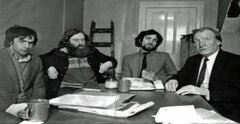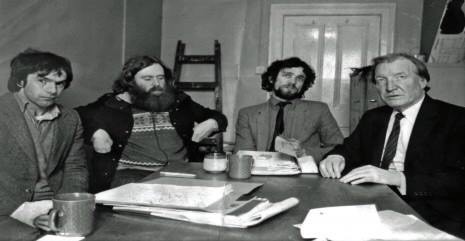It was 40 years ago today.
Reflections on the Gregory Deal 1982 by Mick Rafferty
1982 was to be a pivotal year in the up and down chronicles of the North inner city of Dublin. Planned for the Summer of that year was a month-long multiple arts event called the “The looking on festival”. The concept behind this event grew out of a one-day music festival called the “Diamond Remembered Festival.” This was organised to mark and commemorate the beginning of the demolition of an area in the inner city surrounding by Summerhill, Gardiner Street and Sean McDermott Street. This contained a tarmacadam pitch on which were held community festivals and seven aside soccer competitions in which amateur players as well as league of Ireland and professionals playing overseas took part. The decision had been made in 1978 to depopulate and demolish all the Georgian houses in that historic area. These buildings which once housed the aristocracy now housed about 800 Dublin Corporation tenant families, probable close to 4000 people. The area was adjacent to the infamous Monto area in which madams ruled the roost in their brothels until the campaign by Frank Duff and his legion of Mary in the mid-twenties to rid the city of the scourge of prostitution. This area was made famous in the Night town section in Ulysses, the Circe Chapter in which Bloom follows Stephen into the area to save him and ends up in the famous Bella Cohens brothel. O’Casey’s triumphant trilogy of working-class life were based in this area. The area was thus steeped in the literary and historic events of Dublin from the act of union, the famine, the period of reaching independence, through the emergency and the transition from a largely rural society to a post-industrial one.
And yet by the late seventies the conditions that the people lived under 5 minutes’ walk from O’Connell Street were captured by Don Baker in his “Inner City song” from 1979:
Now Dublin’s inner city is a sorry sight to see
A mass of filthy buildings strife and poverty
The people find it hard to make ends meet
Most of the time
And you’re surprised that they should turn to crime.
The Looking On Festival was to be a challenge for the State to look at the inequality of the city and do something about it but also to ask the people of the area what future they wanted for themselves and act to help realise it.
Between the Diamond Remembered and the Looking On festivals something happened which would change the way the inner city was viewed nationally. On the 18 February 1982 the second general election occurred in less than nine months and a young champion of equality for the inner city was elected by the name of Tony Gregory. What was startling about this first-time elected TD was that by a fluke of our beautiful proportional representative electoral system he held the balance of power. The next few weeks was a hectic time for a small group of community activists. Tony almost immediately received invitations from the main political parties to have discussions about his support for them. Charlie Haughey, the Leader of Fianna Fail, initially wanted to meet Tony on his own but he insisted that he would only meet the contenders for Taoiseach accompanied by members of his team. Both Haughey and Garret Fitzgerald, leader Of Fine Gael, agreed to meet the Gregory team in a dilapidated community office in Summerhill Parade near Ballybough while Michael O’Leary insisted that we meet him in Wynns Hotel near O’Connell Street.
The Gregory team draw up a one-page bullet list of key demands which was made up of the issues we had been dealing with for the previous ten years. The key ones concerned housing, employment, education, the proposed motorway, health and the environment, the future of the now vacant land in the docks. The list also included proposed new structures for the delivery of the new policies e.g. the setting up of an Inner City Authority with Tony as the chairperson and a new development structure for the social rejuvenation of the 27 acres in the Custom House Docks. This list was presented to each contender for Taoiseach with a face-to-face meeting with each for detailed clarification on each issue.
Haughey was always on his own when he met us, and we got the impression he enjoyed the directness and sharpness of our demands. He constantly said, ‘you’re pushing an open door lads.’ He came back each time with precise costings and realistic timetables to deliver on the issues agreed upon. And so, we collectively agreed that what Haughey was offering was more realistic and practical than what Fitzgerald had to offer, and the deal was signed on the Monday 8 March witnessed by the General Secretary of the Irish Transport and General Workers Union, Michael Mullins. Some commentators put the cost of the package agreed upon as 100 million punts. The vast disappointment from our point of view was that the Haughey Government fell in November of 1982. Despite surviving the scandals of that year including the MacArthur GUBU affair the Haughey Government was defeated in a vote on the November budget which they called ‘The Way forward.’ Tony abstained. Some key policy initiatives were put in place such as on housing employment and education but the opportunity to deal with the inner-city problem in a holistic integrated manner was lost.
Since 1982 there have been three significant incentives from the state which responded to issues affecting the inner city.
In the mid-nineties the decision was made to extend the Dockland Development Authority from the original 27 acres right across the rest of the land to the sea. We were continuously critical of the model and Liz McManus, then Minister of State, in the Department of Environment rung us up and asked what our issues were. We explained that we wanted to put into the new legislation a guarantee of community gain and community representation in the dockland redevelopment. And this she did. This positive community partnership was dismantled as soon as the crash occurred in 2009 and Dockland redevelopment left back to the dictates of the private sector.
In June 1996, the courageous journalist Veronica Guerin was assassinated by drug dealers. This awoke the establishment from its indifferent slumbers to the drug crisis. Pat Rabbit, then a Minister for State for Commerce, Science and Technology contacted the CityWide Drug Crisis campaign which had been initiated by community groups in the north inner city and asked, “what are you suggesting we do?” What emerged was a national drug strategy which was largely based on a pilot scheme that had developed in the north inner city.
The third initiative was a response to the gangland feud which began with the shooting of Gary hutch by the Kinahan mob in the Costa del Sol in September 2015. Over the next 3 years 18 people would die as a direct result of the feud some with no connection to the contending family gangs. The response of the State was to commission consultant Kieran Mulvey to investigate and make recommends. His report in 2017 called “Creating a Brighter Future” some would argue was a watered-down version of the Gregory deal for slow learners. There are many positive aspects to the North East Inner City Initiative which resulted as a result of the Mulvey report, not least given community groups a sense of involvement and that there is a fund to respond to the many complex needs of people living in a changing city as they arise. It obviously helps that the Minister for Finance, Pascal Donohue, is a local TD. The problem is that the initiative is decades too late and that the structural problems which created inequality and alienation had taken deep roots and now the same forces are not just an inner-city problem but a widespread urban one and indeed national one requiring imaginative anti-poverty, anti-inequality programs
Looking back, we accepted that the inner city was on the verge of massive change and the goal of the Gregory deal was to put in place policies that would ensure that the local communities would benefit by direct government intervention. The vision was that instead of our young people falling prey to crime, drugs, and imprisonment they could, while living in the old communities, engage with the new economy and become Filo fax carrying yuppies and embrace the new financial services economy. 40 years later that still remains the challenge.

Tony Gregory RIP Fergus McCabe RIP Mick Rafferty Charlie Haughey RIP
Photo: Brendan Walsh: Lilliput Press. 01 671 1647
Taken in Late February 1982 at the second meeting of the Gregory team with Charlie Haughey, leader of Fianna Fail; both myself and him are looking at the bulb above which hadn’t a shade so there was a glare. Haughey said, ‘Regardless of the outcome of our discussions I will get a shade for that bulb.’ He never did but we did get a multifaceted package worth about £100 million for inner city rejuvenation.
Mick Rafferty remains active in the inner city. He is involved in a drama group Uncut Diamonds; with AkiDwA, a support group for immigrant women and with a group developing an archive of community development in the north inner city over the past 50 years dedicated to the memory of the late Fergus McCabe.
